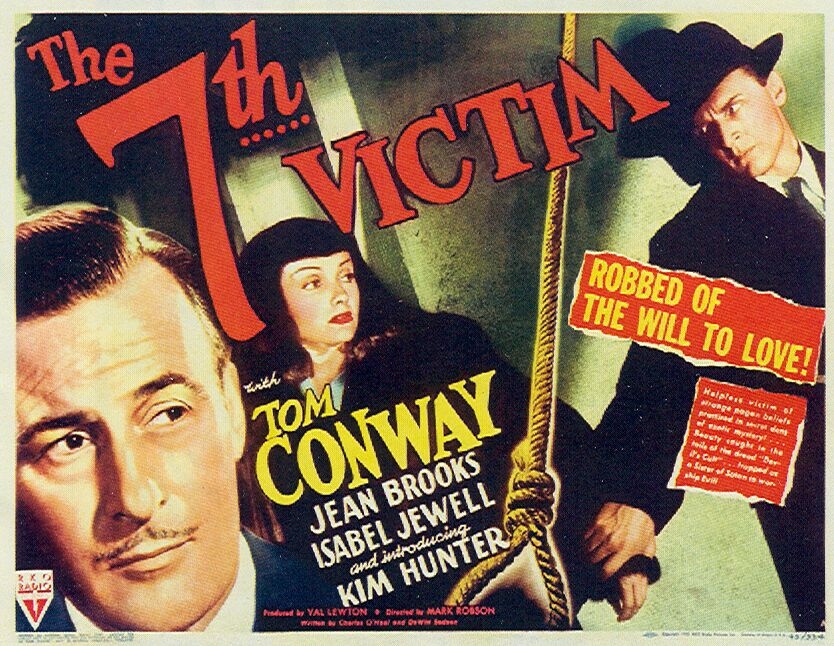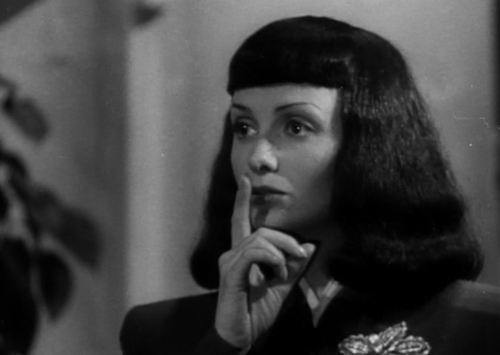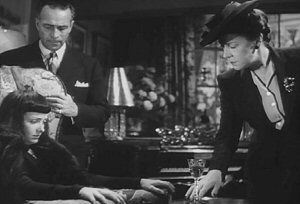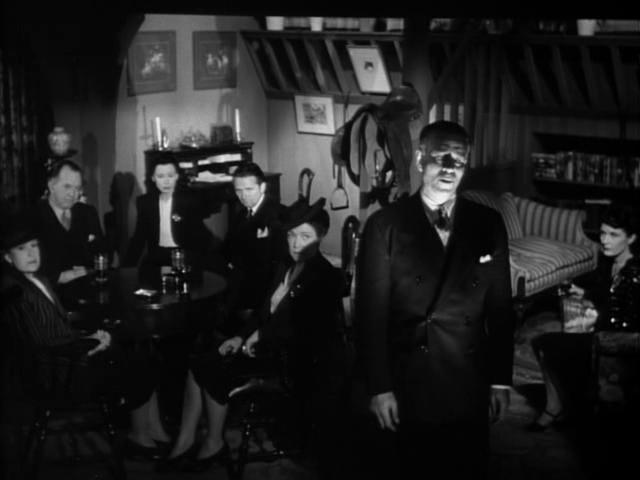As always, assume this discussion (of a film over seventy-years-old!!!) contains spoilers.
Every Halloween I always promise to myself that I will watch all the old horror films that I feel I should have watched. As a fan of the genre, I have watched precious few of the early horror films and even fewer of the 1960s and 1970s fare and am unable to hold my own in conversations about Hammer films. But I have to confess that I can never get through older films with legends like, say, Boris Karloff or Vincent Price, without wishing I was in space with two robots sitting next to me.
It was a simpler time. I know that. What frightened people eighty to ninety years ago is going to seem a bit quaint and possibly silly to a modern audience. I guess I am a result of growing up with John Carpenter’s Halloween films and the Friday the 13th and Hellraiser franchises, which are now cheesy in their own way, come to think of it. So I’ve been looking for an old horror film I can watch without mockery and I came close with The Seventh Victim.
I learned about The Seventh Victim watching a documentary about horror films – it may have been Nightmare in Red, White and Blue but it’s been a while. I filed it away mentally because it sounded interesting – the description of “a woman who dreams of death meets a woman desperate to live” or words to that effect plus a possible Satanic cult and of course I would eventually want to see this film.

It wasn’t entirely as described but it was still interesting. Made in 1943, it presented a very calm and genteel look at human evil while using some tropes that I have come to associate with Hitchcock and Polanski. The femme fatale was surprisingly fragile, the teen sister looked like she was in her thirties, and all the men were sort of… dumb and/or sappy, but I think this film worked so well because it had elements of some of the more sophisticated horror movies, fare that genuinely unsettled me the first time I saw it. Christopher Lee as a vampire and Boris Karloff as a mummy never scared me, even as a kid, but Janet Lee in a shower and a cabal of Satanists in a swanky New York apartment seeking their heir did. Before I discuss this film, here’s a quick synopsis:
Mary Gibson, attending boarding school, finds out her older sister Jacqueline has gone missing. Jacqueline is her only family and has not paid Mary’s school fees so Mary decides she needs to try to find her sister. She travels to New York and discovers her sister had given away her cosmetic factory and salon to an employee called Esther Redi. She manages to trace the man whom she ultimately learns to be Jacqueline’s husband, Gregory Ward, and with him and a very sketchy psychiatrist, whom I think was the same psychiatrist in Cat People, and a dopey poet they manage to find Jacqueline. Jacqueline, who killed a private eye who was looking for her, is in hiding from both the law and a cabal of Satanists who think she has betrayed them by telling the psychiatrist, Dr. Judd, about them. Only six people have crossed this cult before and all were killed, and Jacqueline is to be their seventh victim, giving us the title of the film.
Though some of the characters were hokey – seriously someone needed to punch the stupid poet – this short, melodramatic little film was pretty good. Kim Hunter played Mary, the naive and innocent girl gone to the big city alone to find her sister. The terrible hair and fashion of the time made her look so much older than she was, but Hunter managed to pull off a neat balance between terrified virgin and intrepid girl scout on a mission. She stays in New York, Gregory Ward helps her get a job, she takes a room over an Italian restaurant (called Dante’s) and is pretty resilient without being too plucky to be unendurable.
Early on, Mary is helped by a private detective who realizes that Jacqueline is being held in a locked room at her salon, and she accompanies the PI to the salon at night and is too terrified to open the door herself. The PI reluctantly does it and she hovers in the shadows, frightened to her core, and later we learn that Jacqueline was indeed in that room and was convinced a member of the Satanic cult had come to kill her. The PI drops to the floor, having been stabbed with a pair of scissors, and Mary runs away, leaving him there. Initially, this scene seemed off, but later I realize how well it worked because what was Mary to do? He was dead, she couldn’t have removed him, and she had no idea how he came to be stabbed – was the killer still there? The fear and flight were the right reactions.
Gregory Ward, played by Hugh Beaumont (yep, Mr. Ward later became Ward Cleaver), knows he is being cuckolded by Dr. Judd, but is so taken with Jacqueline’s exquisite beauty and cluster-B tendencies that he supports her even on the run, though when he finds out she is a killer he encourages her to turn herself in. He also finds himself falling in love with Mary, probably because she is so uncomplicated. He abetted Jacqueline’s craziness to a shocking degree, and she was nuts, no two ways about it. Jacqueline was obsessed with death and suicide. Because she was so interested in death, she rented a room – over Dante’s restaurant – and the only things in the room were a noose and a chair. Gregory Ward kept up the rent on that room because he was besotted with what sounds like the mercurial nature of the personality disordered.
Interestingly, everyone felt Jacqueline was one of the most beautiful women they had ever seen. When we finally meet her, it’s a hoot. She’s a bog-standard proto-goth, down to the dyed-black hair and uneven baby bangs. Her affect is utterly flat, she seems to get by on her quirkiness (death obsessed, continually telling charming lies, being the sort who would get in deep with Greenwich Village Satanists and then rat them out in therapy), and given that this film is ostensibly about finding her it matters very little when she is found.

Dr. Judd, Gregory Ward, the poet whose name really doesn’t matter, and Mary finally track Jacqueline down and drag her back to Mary’s apartment to stay until Gregory can arrange a good time for her to turn herself in for killing the PI. But they don’t count on how intrepid the Satanists are. They find Jacqueline and escort her to their lair, which is an apartment and filled with a cast of characters we met earlier during a party (the woman who owns the apartment has one arm, inexplicably), and give her poison to drink.
But this cabal of Satanists are civilized. They will not kill her. They will just pressure her to commit suicide unless she refuses and then, maybe, they will kill her.

Unsure why this cabal exists – they seem to just like having parties and talking about being bad while not actually being bad – but among them are Esther Redi and an extremely emotional hairdresser who worked for the salon Jacqueline owned. When Jacqueline seems to be close to drinking the poison, the hairdresser loses it and breaks the glass and the cult sends sullen, affect-less Jacqueline on her way, only to follow her and try to kill her. Jacqueline gets away, desperate to live, and races back to Mary’s apartment above the restaurant.
It is here that she encounters the dying woman who wants to live. We had seen glimpses of Mimi, the coughing, dying wraith who lives in the building with the poet and Mary, but this is the first time she speaks. Jacqueline, so paranoid she sees this sick woman and is fearful she is part of the cult, demands to know who she is, and Mimi explains that she is dying and that she is tired of being sick. She wants to go out dancing and drinking and have fun, if only for one night, and then she might end it all. She will only kill herself because she so wants to live and is sick of not enjoying life as she slowly dies from her illness. Jacqueline, having refused to kill herself and having fought to remain alive, sees Mimi and rushes to her rented room and hangs herself. Don’t ask me why. Not the reaction I would have had. Conveniently her death clears the path for Mary and Gregory to be together, and Mimi does indeed dress up and have a lovely night on the town.
I was rather surprised by the way the Satanic cult was handled. The cult called themselves Palladists – presumably a name that nods to Pallas Athena – and looked like a 1940s bridge tournament was being held. The only one who seemed the least bit odd was the woman with one arm. Otherwise they seemed perfectly normal, got up to little that was evil – killing only those who threatened the cult and adhering to non-violence whenever possible – yet operated in such secrecy that one was certain that some horrible stuff had to have gone down at some point. One does not keep a 1940s exemplar of borderline personality disorder locked away in a room for months and later plan her death for squealing if one’s dopey cult does little more than hold interesting salon-style soirees and occasionally hail Satan.

The cult reminded me a bit of the Satanists in Rosemary’s Baby, another New York Satanic cult that would not have raised an eyebrow initially, consisting as it did of daft old ladies like Ruth Gordon. Ultimately we saw what the cult that impregnated Rosemary Woodhouse was about, but in the 1940s I supposed filmmakers had less leeway to present Satanic evil to its fullest cinematic glory. In a way, if you know real life Satanists, the vast majority likely live lives not dissimilar to the lives of the Greenwich Village Satanists in The Seventh Victim, hosting tea parties and discussing the human will. Leave out the stalking and killing part and it was a surprisingly modern approach to Satanists. But since the stalking and murder were a part of this cult, it definitely harked back to Rosemary’s Baby – those who are genuinely evil in your midst may be the last people you would suspect.
Then there was the shower scene. Janet Leigh being stabbed to death in Psycho was more than fifteen years away from hitting the silver screen, but I’ve seen it, as have most horror fans, and that scene definitely colored how I viewed Mary’s shower scene. Mary had gotten her hair done at the salon her sister once owned, and had pumped the hairdresser for information about Esther Redi. Esther Redi finds out and goes to confront Mary. Mary lives in a single room over Dante’s Restaurant, and shares a bathroom with other tenants. She is in the shower, complete with shower cap to cover her freshly styled hair, when Esther Redi enters the bathroom, which presumably Mary forgot to lock.
We do not know much about this cabal of Satanists that Esther Redi belongs to, but it is never good when a young girl is caught at such a disadvantage. The shower curtain is clear so we can vaguely see Mary’s essential outline from Esther’s perspective. However, from Mary’s perspective, all we can see is Esther’s backlit shadow towering over her. But thankfully the Palladists are, at their core, gentle Satanists and Esther simply warns Mary away. But the menace was clear – Esther could get into the bathroom, and presumably into Mary’s room, and had no trouble sneaking up on the naive teen when she was at her most vulnerable.
The use of showers in horror films is a ringer – it’s almost too easy – young person, generally a woman, naked and defenseless, becomes an easy and titillating target for the killer/supernatural monster. But I note that in most “best shower scene in a horror movie lists,” the lists don’t include any films prior to 1960’s Psycho. Did this shower scene in the 1940s cause viewers the same apprehension it did me? Did that menacing silhouette have anything close to the same baggage then as it does post-Psycho? As I went looking for stills to demonstrate the scene, I found this snippet of the film on YouTube. The person behind this account clearly felt the same way I did.
This was not a terrifying film, but there were enough modern signifiers – a death-obsessed woman whose appearance was a precursor to more modern female death junkies/manic-depressive dream girls, Satanists that were not goat and baby sacrificing lunatics and judicious use of shower-menace – that it set far better with me than early monster movies and seriously hokey Hammer films (god, I want to enjoy Hammer films but they are just so purple and over the top and it makes me feel like a crappy horror fan that I sort of recoil when I hear the names Christopher Lee or Ingrid Pitt). I recommend watching it if you can find a copy. It’s not too hard, because you can stream it from Amazon.
If you watch it, let me know what you think. Feel free to make fun of me for not liking Hammer films. I’m used to it.